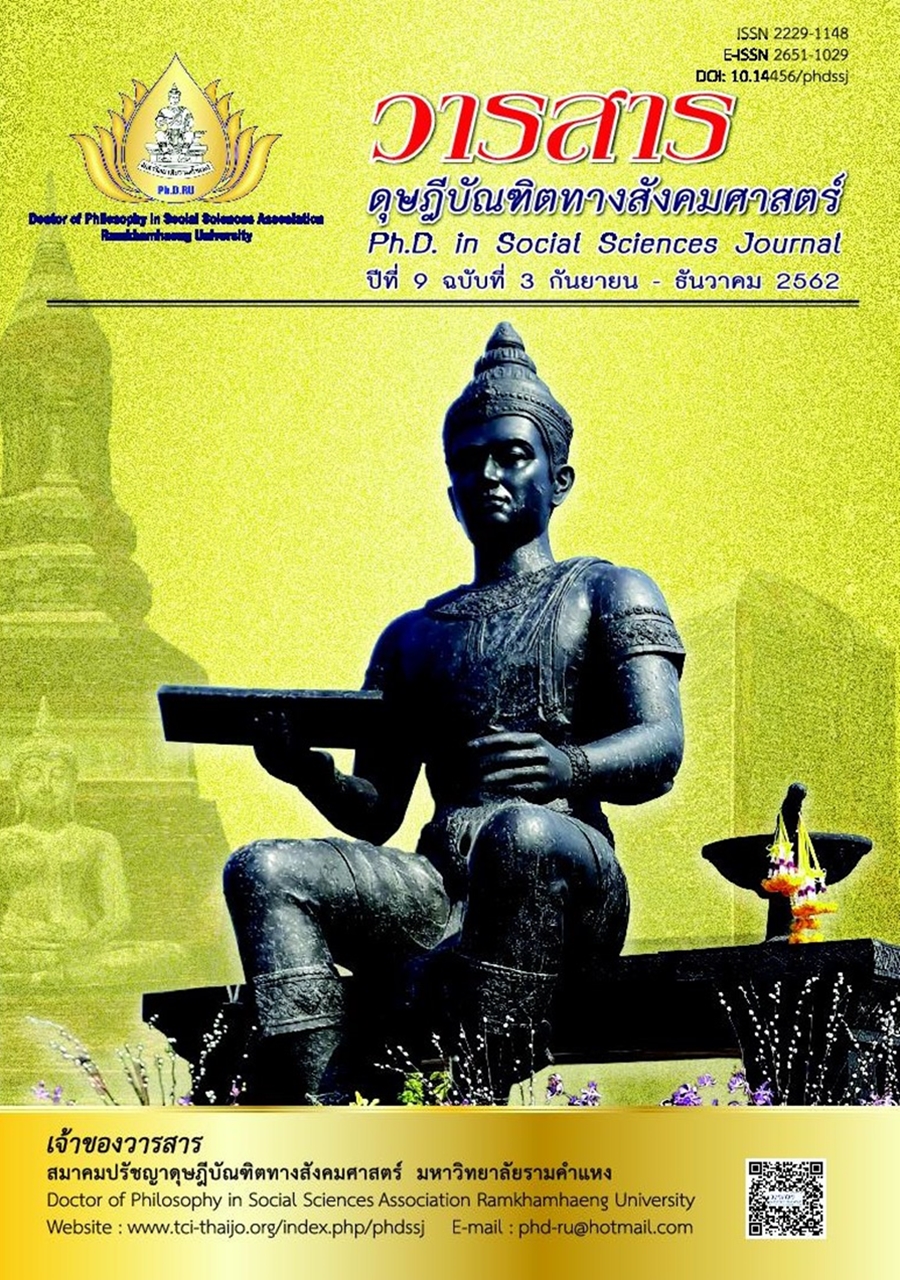An Analysis of Specialized Bank Operation That Conduct Real Estate Transactions in Thailand
Main Article Content
Abstract
This research has goal: (1) to study the operations of specialized bank (2) to analyze the operating efficiency level of the specialized bank prior before and after the period of Thailand reform. This study is based on the population: 2 large specialized banks, government savings bank and government housing bank. This research uses the study from the document, based on secondary data, from the bank’s financial statements and other relevant information in 2003-2017 to analyze the fifteen-year data and Data Envelopment Analysis: DEA to answer the research objectives.
The finding showed that:
2. the government savings bank is a leader in promoting savings and the government housing bank is the best bank for having a home
2. the operating efficiency level of the specialized bank that conduct real estate transactions prior before and after the period of Thailand reform not different at the significant level of 0.01.
Article Details
Academic articles, research articles, and book reviews in the Ph.D. in Social Sciences Journal are author’s opinions, and not the publisher’s, and is not the responsibility of the Ph.D. in Social Sciences Journal Philosophy Association, Ramkhamhaeng University. (In the case that research is done on human, the researcher has to be trained in Ethics for Doing Research on Human Training and has to produce the evidence of the training).
References
Bank of Thailand. (2015). Structure of the Thai financial system. Retrieved from https://www.bot.or.th/Thai/FinancialInstitutions/FIStructure/Pages/default.aspx [In Thai]
Bhuia, M. R., Baten, A., Kamil, A. A., & Deb, N. (2012). Evaluation of online bank efficiency in Bangladesh: A Data Envelopment Analysis (DEA) approach. Journal of Internet Banking and Commerce, 17(2), 1-17.
Chansarn, S. (2014). Total factor productivity of commercial banks in Thailand. International Journal of Business and Society, 15(2), 215-234. [In Thai]
Chen, X., Skully, M., & Brown, K. (2005). Banking efficiency in China: Application of DEA to pre- and post-deregulation eras: 1993-2000. China Economic Review, 16(3), 229-245.
Chunhachinda, P., & Li, L. (2010). Efficiency of Thai Commercial Banks: Pre- vs. Post-1997 financial crisis. Review of Pacific Basin Financial Markets and Policies, 13(3), 417-447.
Deng, Q., Wong, W. P., Wooi, H. C., & Xiong, C. M. (2011). An engineering method to measure the bank productivity effect in Malaysia during 2001-2008. Systems Engineering Procedia, 2, 1-11.
Diler, M. (2011). Efficiency, productivity and risk analysis in Turkish banks: A bootstrap DEA approach. Journal of BRSA Banking & Financial Markets, 5(2), 71-133.
Farrell, M. J. (1957). The measurement of productive efficiency. Journal of the Royal Statistical Society, 120(3), 253-281.
Gardener, E., Molyneux, P., & Nguyen-Linh, H. (2011). Determinants of efficiency in South East Asian banking. The Service Industries Journal, 31(16), 2693-2719.
Government Housing Bank. (2018). Annual report (2009-2018). Bangkok: Author. [In Thai]
Government Savings Bank. (2018). Annual report (2009-2018). Bangkok: Author. [In Thai]
Hadad, M. D., Hall, M. J. B., Kenjegalieva, K. A., Santoso, W., & Simper, R. (2011). Productivity changes and risk management in Indonesian banking: A Malmquist analysis. Applied Financial Economics, 21(12), 847-861.
Havrylchyk, O. (2006). Efficiency of the Polish banking industry: Foreign versus domestic banks. Journal of Banking & Finance (Special Section: Banking and Finance in an Integrating Europe), 30(7), 1975-1996.
Krasachat, W., & Chimkul, K. (2005). Determinants of banking productivity in Thailand 1990-2004. Paper presented to the International Workshop on Performance Management, Beijing, China.
Kumar, M., Raman, J., & Raman, P. (2015). A fuzzy DEA approach for effectively measuring the efficiency of Indian banks. The IUP Journal of Bank Management, 14(1), 21-38.
Minh, N. K., Long, G. T., & Hung, N. V. (2014). Efficiency and super-efficiency of commercial banks in Vietnam: Performances and determinants. Asia-Pacific Journal of Operational Research, 30(1), 1-19.
Okuda, H., Poleng, C., & Aiba, D. (2014). Operational efficiency and productivity change of major Cambodian financial institutions during the 2006-2011 period. International Journal of Business and Information, 9(3), 335-360.
Pattamasiriwat, D. (2002). Earning income of municipalities Empirical research using the DEA model. Phitsanulok: Naresuan University. [In Thai]
Rezitis, A. N. (2004). Productivity growth in the Greek banking industry: A non-parametric approach. Journal of Applied Economics, 5(1), 119-138.
Stavarek, D. (2003). Banking efficiency in Visegrad countries before joining the European Union. Paper presented to the Efficiency of Financial Institutions and European Integration, Lisbon, Portugal.
Sufian, F. (2010). The impact of the Asian financial crisis on bank efficiency: The 1997 experience of Malaysia and Thailand. Journal of International Development, 22(7), 866-889.
Sufian, F. (2011). Financial repression, liberalization and bank total factor productivity: Empirical evidence from the Thailand banking sector. Economic Computation & Economic Cybernetics Studies & Research, 45(4), 1-22.
Sufian, F., & Habibullah, M. S. (2010). Developments in the efficiency of the Thailand banking sector: A DEA approach. International Journal of Development, 9(3), 226-245.
Thoraneenitiyan, N., & Avkiran, N. K. (2009). Measuring the impact of restructuring and country-specific factors on the efficiency of post-crisis East Asian banking systems: Integrating DEA with SFA. Socio-Economic Planning Sciences, 43(4), 240-252.
Yang, Z. (2009). Using DEA-neural network approach to evaluate branch efficiency of a large Canadian bank. Expert Systems with Applications, 31(1), 108-115.

